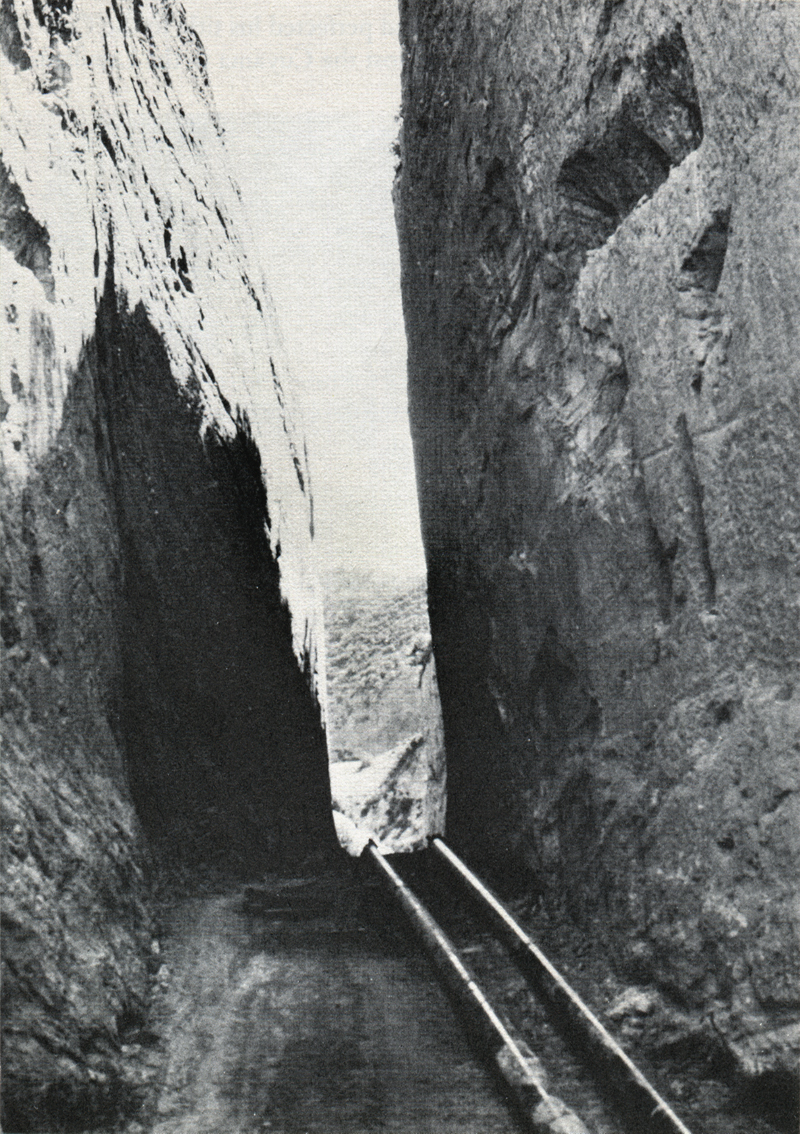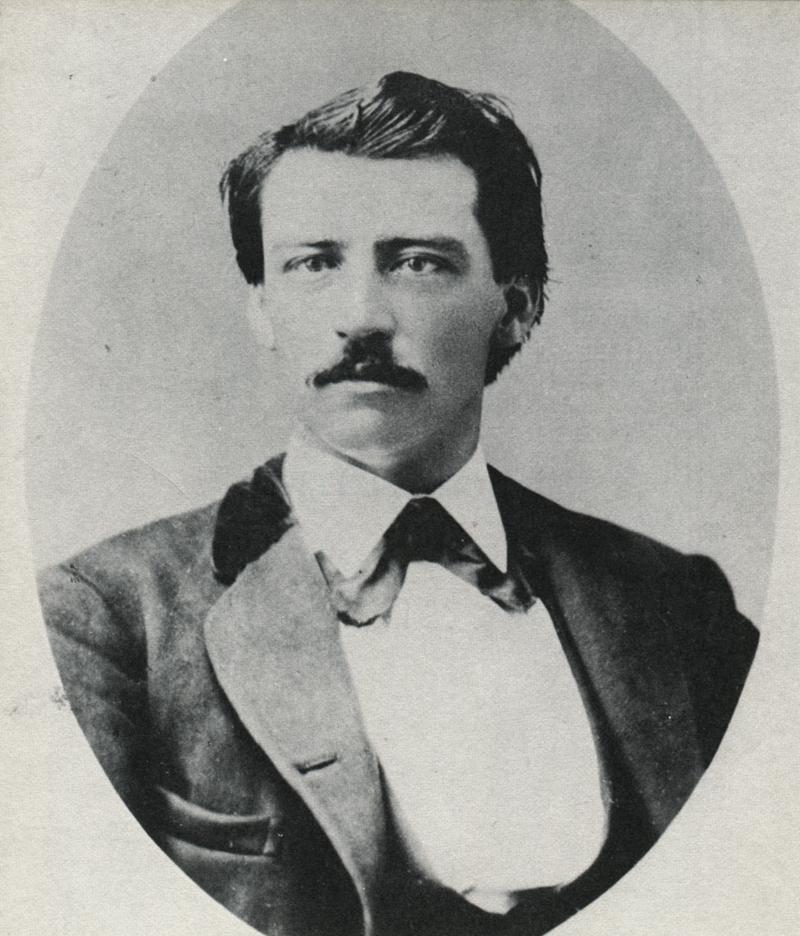|
|
"The Beale Cut."
As told by José Jesús López.
From "Saga of Rancho El Tejon" by Frank F. Latta | Santa Cruz: Bear State Books 1976 | pp. 195-197.
|
The "Beale Cut," made through the sandstone hill three miles below Newhall, was made by General Beale in the 1850s [sic; s/b early 1860s] as a toll road under a twenty-year charter from Los Angeles County. I believe that the City of Los Angeles secured the charter for General Beale [sic; s/b County]. Understand, the cut was made by hand labor with pick and shovel and the use of some powder. This cut was made before the Telegraph and the Overland State Line were established [sic; Overland Mail Co. est. 1857/58]. Even after the cut was made, it was a steep grade to climb with teams and loaded wagons. My father used to keep two span of oxen and a driver there to help pull rigs and wagons and the stages over it. Teamsters from the San Joaquin Valley, Tehachapi and Cummings Valleys had to have a lift through the cut, even after the telegraph line was built. Teamsters would telegraph my father when they would be at the cut, and he would have double yokes of oxen there to help them make the pull. Before the cut was made, all travel, including the stages, went around the hill near where the cut is now, and over a grade much steeper than the one in the cut. Don Antonio del Valle used to take ox carts over a much steeper hill south and east of present Newhall. It seems almost impassable for ox carts, but Don Antonio himself told me that two yoke of oxen used to pull an empty carreta to the top of that hill, going directly up the west side. [Note: Antonio del Valle didn't tell Lopez anything because Antonio died in 1841 and Lopez was born in 1853. Perhaps Lopez means Antonio's son, Ygnacio — Ed.]
About José Jesús López, Majordomo of El Tejon Excerpts from "Saga of Rancho El Tejon" by Frank F. Latta (Santa Cruz: Bear State Books 1976). The book is written in the voice of José Jesús López (1853-1939), "as told to" Latta in a series of interviews conducted between 1916 and the 1930s.
Preface (by Latta), pg. xi. José Jesús López was one of the most colorful pioneers ever to operate a stock ranch in California. He came from one of the oldest and most numerous California families. It is probable that ancestors of his parents came to Alta California in 1769 with Gaspar de Portola and Father Junipero Serra. Records show that on September 8, 1771, Juan Francisco López was in the soldier escort and guard at the founding of Mission San Gabriel. In 1872, after his family had been in California more than one hundred years, Don José made a visit to the San Joaquin Valley and in 1873 he returned with a band of sheep, returned to stay. Not only did he have a good education; he was one of the most able and intelligent Californios of his time. So he was not destined to herd sheep for long. In 1874, Edward F. Beale, owner of El Tejon Ranchos, purchased part of the López sheep and employed him to handle all of the sheep on the ranchos. The sheep at one time totaled ninety-five thousand head, ranging more than 300,000 acres of land, four Mexican Land Grants, and included Ranchos El Tejon, La Liebre, Castaic [Castec] and Agua Caliente. Don José continued in charge of the sheep operation until 1885, after Beale had sold most of the sheep and stocked the ranchos with cattle. Beale then placed Don José in charge of the entire stock operation. He continued in the employ of Beale until Beale died and the ranchos were sold to a Los Angeles company by his son, Truxton Beale. He also continued with this company as active, and later as consulting cattle boss until the time of his death in 1939. It was in 1916 that I first met and interviewed Don Jose. [...] Chapter 1: From Old Spain (voice of López), pp. 1-3. My López ancestors were from Old Spain, Province of Asturias. At one time some of them, not by the name of López, lived in Seville. But the old López grandparents claimed to be Castilianos, Castillians. They had some French and Arabian blood. Ygnacio López, born in Mexico, was the founder of the López family in Alta California. Some of our family say that Ygnacio and his sons, Juan and Juan Francisco, both born in Baja California, came to Alta California in 1769 [...] Coming from Baja California, the López families went first to the state of Michoacan on the mainland and waited for an expedition to come north. They arrived in Michoacan just in time to help put down a revolution. Later, in recognition of this service, Juan and Claudio were given charge of the Indians building two of the missions, Claudio those at San Gabriel, and Juan those at San Fernando. Juan's son, Pedro, followed his father as Mayordomo over the Indians at San Fernando. This Pedro was my mother's father. Our López family came from a long line of Spanish army officers, continuing back to the time of the Conquest of Mexico, when another Juan López served as a Conquistador under Hernán Cortés. Ygnacio López' wife was María Recunda de Mora de López. There is a family tradition that this López family was connected with the Duke de Medina through these Moras. However, I have never seen any records to prove this. Claudio López was a brother of Juan and Juan Francisco. He was my great grandfather. He and his wife, María Luisa Cota de López, are buried inside the San Gabriel Mission Church. On their way to Alta California, three of the López families stayed in the state of Michoacan for a number of years, waiting for an expedition to come to Alta California. Things moved slowly in those days and the expedition was years in being organized. At last, three of the families moved up into the state of Sonora and stopped near Ures. This move was made because they thought they would be able to come sooner if they were close at hand, for the outfitting posts were on the frontier. They were in Sonora two years before they were able to come to Alta California. Both my father, Jerónimo, and my mother, Catalina, were named López. My mother was the daughter of Pedro López, and the granddaughter of Juan López and María Dolores Salgada de López. My father was the son of Esteban López and the grandson of Claudio López and María Luisa Cota de López. Claudio was Majordomo at San Gabriel Mission for more than forty years. [...] For his long service at San Gabriel, Claudio was granted the use of Rancho Anita, which later was known as Rancho Santa Anita. He did not name the rancho for the Saint. He named it for beautiful Anita Cota. He expected to marry her, but she died and he later married her cousin, María Luisa Cota. [...] In 1826 he became Alcalde of Pueblo de Los Angeles. From my parents and from the generation of my grandparents, I learned that in Spain our López family was very wealthy and belonged to the aristocracy of Castile. Of course I did not know the original Claudio or any of his brothers or sisters, but my grandfather, Pedro López, did. Both Chico and Pedro López told many stories about all of these original colonists. The original brothers, Claudio, Juan and Juan Francisco, had two sisters who came to California. One, María Francisca, married an Ortega and the other, María de la Encarnación, married a Verdugo. You see, through these early marriages, I am related to almost every person in Southern California who is descended from the early Spanish colonists. [...]
|
J.J. Lopez Story
1890-1910
South View
ca. 1900/1910
Postcard 1911
FILM: Broken Ways 1913
Man Walking 1910s/20s
"3 Jumps Ahead" 1923
FILM: The Devil Horse 1932
Toll House 1938
"Stagecoach" Scene 1939
Landmark Effort 1940
"Cowboy Serenade" 1942, Not Beale's Cut
Hiking Guide 1964
|
The site owner makes no assertions as to ownership of any original copyrights to digitized images. However, these images are intended for Personal or Research use only. Any other kind of use, including but not limited to commercial or scholarly publication in any medium or format, public exhibition, or use online or in a web site, may be subject to additional restrictions including but not limited to the copyrights held by parties other than the site owner. USERS ARE SOLELY RESPONSIBLE for determining the existence of such rights and for obtaining any permissions and/or paying associated fees necessary for the proposed use.














